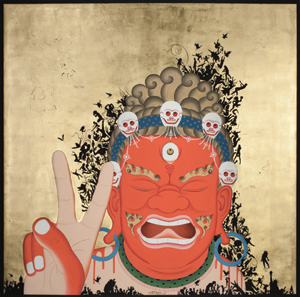
A dharma teacher who visits the Tricycle editorial office each time he’s in town has for some time been pushing us to run a series of articles on anger. I’ve resisted for many months, even a few years, pointing out that we’ve been there, done that. “Well,” he’d quip with a shade of irritation in his voice, “people are still angry.”
I hadn’t meant to ruffle his robes, and he had a point. Nowadays, people seem even angrier than when we last devoted a section to the topic. I suppose you could say we had unrealistic expectations. That was back in the flush ‘90s, when it was a lot easier than it is now to buy your way out of a bad mood, or at least try to. These days, we’ll have to settle for practice, which is not such a bad option to be left with, provided we’ve still got food in the fridge and a roof over our heads. Anger remains one of our richest opportunities for practice. As the great 8th-century Buddhist sage Shantideva writes:
Unruly beings are as (unlimited) as space:
They cannot possibly all be overcome,
But if I overcome thoughts of anger alone
This will be equivalent to vanquishing all foes.
But don’t we have a right to be angry? Can’t anger sustain us in righting, say, what we find so wrong in the world? We may think so, but Shantideva makes the point that the risks are high if we let anger rule us:
Whatever wholesome deeds,
Such as venerating the Buddhas, and generosity,
That have been amassed over a thousand aeons
Will be all destroyed in one moment of anger.
So, this issue offers plenty of material to see you through the dog days, beginning with a special section on anger, providing practical advice and sound Buddhist insights. As Jules Shuzen Harris, Sensei writes, “Our meditation practice is also a place where we can work directly with our experience of anger by becoming the anger. To ‘become the anger’ does not mean to act it out. It means we stop separating ourselves from it, experience it fully so that we can experience what’s behind it.” Scholar-practitioner John Makransky draws an important distinction between anger and “wrathful compassion,” while Harris sheds light on the causes of anger that lie inside ourselves, however tempting blaming others may be. And Acharya Fleet Maull introduces his online Tricycle Retreat, presenting a form of social activism whose motivations are not rooted in anger.
As a companion to the special section, Tricycle Members (if you subscribe, you’re a member) can download our latest e-book, Tricycle Teachings: Anger.
Whether in print or online, we look forward to joining you in practice. While anger can be one of our greatest and most difficult challenges, when we deal with it skillfully, it can become one of our greatest opportunities to free the mind.
—James Shaheen, Editor and Publisher
All quotations excerpted from Shantideva’s A Guide to the Bodhisattva’s Way of Life, translated by Stephen Batchelor.
Thank you for subscribing to Tricycle! As a nonprofit, we depend on readers like you to keep Buddhist teachings and practices widely available.